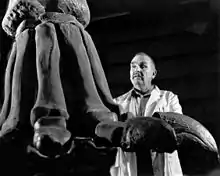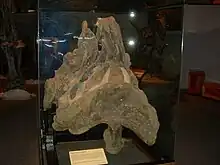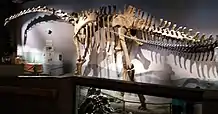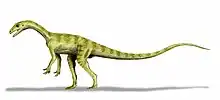Supersaurus
Supersaurus (meaning "super lizard") is a genus of diplodocid sauropod dinosaur that lived in North America during the Late Jurassic period. The type species, S. vivianae, was first discovered by Vivian Jones of Delta, Colorado, in the middle Morrison Formation of Colorado in 1972. The fossil remains came from the Brushy Basin Member of the formation, dating between 153 to 145 million years ago.[1] It was a very large sauropod, with the WDC and BYU specimens reaching 33–35 metres (108–115 ft) in length and approximately 35–40 metric tons (39–44 short tons) in body mass. A potential second species, S. lourinhanensis, (Dinheirosaurus) is known from Portugal and has been dated to a similar time.[2]
| Supersaurus Temporal range: Late Jurassic, | |
|---|---|
 | |
| A cast of BYU 9025, a scapulocoracoid, the holotype of Supersaurus, Dinosaur Journey Museum | |
| Scientific classification | |
| Domain: | Eukaryota |
| Kingdom: | Animalia |
| Phylum: | Chordata |
| Clade: | Dinosauria |
| Clade: | Saurischia |
| Clade: | †Sauropodomorpha |
| Clade: | †Sauropoda |
| Superfamily: | †Diplodocoidea |
| Family: | †Diplodocidae |
| Subfamily: | †Diplodocinae |
| Genus: | †Supersaurus Jensen, 1985 |
| Type species | |
| †Supersaurus vivianae Jensen, 1985 | |
| Other Species | |
| |
| Synonyms | |
|
Genus synonymy
Species synonymy (S. vivianae)
| |
Discovery
Supersaurus is present in stratigraphic zone 5 of the Morrison, dating from the Tithonian.[3] The original fossil remains of Supersaurus were discovered in the Dry Mesa Quarry in 1972. This find yielded only a few bones: mainly the shoulder girdle, an ischium, and tail vertebrae. Paleontologist James A. Jensen described Supersaurus; he designated a scapulocoracoid BYU 9025 (originally labeled as BYU 5500) as the type specimen. This shoulder girdle stood some 2.4 meters (8 ft) tall, if placed on end. The specimen was given the name "Supersaurus" informally as early as 1973,[4][5] but was not officially described and named until more than a decade later, in 1985.[6] Sauropod researcher Jack McIntosh at one time thought that the BYU Supersaurus material might represent a large species of Barosaurus but later felt that there was evidence for Supersaurus being a valid genus.[7]

A much more complete specimen WDC DMJ-021, was found in Converse County, Wyoming in 1986 by Brandon Flyr and Bart Lesco while out hiking and was reported to the people who owned the land at the time. The discovery was later named "Jimbo" in 1996 by the family that purchased the land, it was described and assigned to Supersaurus in 2007. The specimen represented approximately 30% of the skeleton. Its bones are being held at the Wyoming Dinosaur Center. A comparison of WDC DMJ-021 and other specimens previously assigned to Supersaurus was done in order to help decide what material from the Dry Mesa Quarry belonged to the genus. It indicated that a series of tail vertebrae and an ulna may have belonged to some other diplodocid.[8]
Ultrasauros

Jensen, who described the original Supersaurus specimen, simultaneously reported the discovery of another gigantic sauropod, which would later be named "Ultrasaurus" macintoshi[6] (later renamed Ultrasauros macintoshi). The type specimen (the specimen used to define a new species) of Ultrasauros, being a backbone (dorsal vertebra, labeled BYU 9044), was later found to have come from Supersaurus. In fact, it probably belonged to the original Supersaurus specimen, which was discovered in the same quarry in 1972. Therefore, Ultrasauros became a junior synonym of Supersaurus, which had been named first and thus retains priority, and the name Ultrasauros was abandoned.[9]
Other bones that were found at the same location and originally thought to belong to Ultrasauros, like a shoulder girdle (scapulocoracoid, BYU 9462), actually belonged to Brachiosaurus, possibly a large specimen of Brachiosaurus altithorax.[9] The Brachiosaurus bones indicate a large, but not record-breaking individual, a little larger than the "Brachiosaurus" brancai (Giraffatitan brancai) mount in the Berlin's Natural History Museum.[10]

Originally, these Supersaurus and Brachiosaurus bones were believed to represent a single dinosaur that was estimated to reach about 25 to 30 meters (80 to 100 ft) long, 8 meters (25 ft) high at the shoulder, 15 meters (50 ft) in total height, and weighing maybe 70 metric tons (75 short tons). At the time, mass estimates ranged up to 180 tons,[11] which placed it in the same category as the blue whale and the equally problematic Bruhathkayosaurus.
The naming of the chimeric Ultrasauros has a similarly complicated history. Ultrasaurus (with the final "u") was the original choice, and was widely used by the media after the discovery in 1979. However, the name of a new species must be published with a description to become official.[12]

Before Jim Jensen published his discovery in 1985, another paleontologist, Kim Haang Mook, used the name Ultrasaurus in a 1983 publication to describe what he believed was a giant dinosaur in South Korea. This was a different, much smaller dinosaur than Jensen's find, but Kim thought it represented a similarly gigantic animal because he confused a humerus for an ulna. While the logic of naming was incorrect, the Ultrasaurus from Kim's find fulfilled the requirements for naming and became regarded as a legitimate, if dubious genus.[10][12] Thus, because Jensen did not publish his own "Ultrasaurus" find until 1985, Kim's use retained its official priority of name, and Jensen was forced to choose a new name (in technical terms, his original choice was "preoccupied" by Kim's sauropod). In 1991, at his suggestion, George Olshevsky changed one letter, and renamed Jensen's sauropod Ultrasauros, with the final "o".[12]
When it was later discovered that the new name referred to bones from two separate, and already known species, the name Ultrasauros was considered invalid and became a junior synonym for Supersaurus. Since the bones from the Brachiosaurus were only used as a secondary reference for the new species, Ultrasauros is not a junior synonym for Brachiosaurus. The name Supersaurus was kept instead of Ultrasaurus as the animal is a diplodocid and Ultrasaurus had always referred to a brachiosaurid.[9]
Additional synonyms
Another diplodocid dinosaur found near the original Supersaurus quarry, known from a backbone (dorsal vertebra type specimen BYU 5750), was named Dystylosaurus edwini and is now also considered to be a specimen of Supersaurus vivianae. Hence, Dystylosaurus has also become a junior synonym of Supersaurus.[13]
Description


Supersaurus is among the largest dinosaurs known from good remains, with the WDC and BYU specimens reaching 33–35 meters (108–115 ft) in length and approximately 35–40 metric tons (39–44 short tons) in body mass.[8][14] A larger specimen indicating a body length over 39 metres (128 ft) has been described in a 2021 abstract.[15]
The first described specimens of Supersaurus were individual bones that suggested a large diplodocid. A large cervical vertebra BYU 9024 from the same quarry was later assigned to Supersaurus.[16]. This vertebra measures 1.38 m (4.5 ft) in length and is the longest cervical known.[17] This enormous vertebra was reclassified as a Barosaurus vertebra, by Mike Taylor and Matt Wedel.[18] However Brian Curtice has reassigned it to Supersaurus on the basis of additional specimens.[15]
The assignment of the more complete specimen, WDC DMJ-021, to Supersaurus suggests that in most respects it was very similar in anatomy to Apatosaurus but less robustly built with especially elongated cervical vertebrae, resulting in one of the longest known sauropod necks.[8]
Classification
Most studies of diplodocid relationships have found it to contain two primary subgroups: Diplodocinae (containing those diplodocids more closely related to Diplodocus than to Apatosaurus) and Apatosaurinae (diplodocids more closely related to Apatosaurus than to Diplodocus). Originally, it was thought that Supersaurus was related to the long-necked diplodocid Barosaurus, and therefore a member of the subfamily Diplodocinae, however, with the assignment of the more complete WDC DMJ-021 most later studies found Supersaurus to be a close relative of the familiar Apatosaurus in the group Apatosaurinae.[8] However, some later studies cast doubt on this paradigm. One comprehensive study of diplodocoid relationships published by Whitlock in 2011 found Apatosaurus itself to lie at the base of the diplodocid family tree, and other "apatosaurines", including Supersaurus, to be progressively more closely related to Diplodocus (making them diplodocines).[19]

In 2015, a specimen level phylogenetic study of diplodocids found that Dinheirosaurus lourinhanensis grouped with Supersaurus. The study considered that it should be a new species of Supersaurus, in a new combination S. lourinhanensis.[2]
| Diplodocidae |
| ||||||||||||||||||||||||||||||||||||||||||||||||||||||||||||||||||||||||||||||||||||||||||||||||
References
- Kowallis, B.J.; Christiansen, E.H.; Deino, A.L. (1991). "Age of the Brushy Basin Member of the Morrison Formation, Colorado Plateau, western USA". Cretaceous Research. 12 (5): 483–493. Bibcode:1991CrRes..12..483K. doi:10.1016/0195-6671(91)90003-U.
- Tschopp, E.; Mateus, O. V.; Benson, R. B. J. (2015). "A specimen-level phylogenetic analysis and taxonomic revision of Diplodocidae (Dinosauria, Sauropoda)". PeerJ. 3: e857. doi:10.7717/peerj.857. PMC 4393826. PMID 25870766.

- Foster, J. (2007). "Appendix". Jurassic West: The Dinosaurs of the Morrison Formation and Their World. Indiana University Press. pp. 327–329.
- George, J. (May 13, 1973). "Supersaurus, giant of the giants". Denver Post, Empire Magazine. pp. 14ff.
- George, J. (June 1973). "Supersaurus, the biggest brute ever". Reader’s Digest. pp. 51–56.
{{cite news}}: CS1 maint: date and year (link) - Jensen, J.A. (1985). "Three new sauropod dinosaurs from the Upper Jurassic of Colorado". The Great Basin Naturalist. 45 (4): 697–709. doi:10.5962/bhl.part.4439.
- McIntosh, John S. (2005). "The genus Barosaurus Marsh (Sauropoda, Diplodocidae)". In Tidwell, Virginia; Carpenter, Ken (eds.). Thunder-lizards: The Sauropod Dinosaurs. Bloomington: Indiana University Press. pp. 38–77. ISBN 0-253-34542-1.
- Lovelace, David M.; Hartman, Scott A.; Wahl, William R. (2008). "Morphology of a specimen of Supersaurus (Dinosauria, Sauropoda) from the Morrison Formation of Wyoming, and a re-evaluation of diplodocid phylogeny". Arquivos do Museu Nacional. 65 (4): 527–544. ISSN 0365-4508.
- Curtice, B.; Stadtman, K.; Curtice, L. (1996). "A re-assessment of Ultrasauros macintoshi (Jensen, 1985)". In Morales, M. (ed.). The Continental Jurassic: Transactions of the Continental Jurassic Symposium (PDF). Vol. 60. Museum of Northern Arizona Bulletin. pp. 87–95.
- Paul, G.S. (1988). "The brachiosaur giants of the Morrison and Tendaguru with a description of a new subgenus, Giraffatitan, and a comparison of the world's largest dinosaurs" (PDF). Hunteria. 2 (3): 1–14.
- McGowan, C. (1992). Dinosaurs, Spitfires and Sea Dragons. Harvard University Press. ISBN 978-0674207707.
- "Supersaurus, Ultrasaurus and Dystylosaurus in 2019, part 1: what we know now". Sauropod Vertebra Picture of the Week. June 13, 2019.
- Curtice, B.; Stadtman, K. (2001). "The demise of Dystylosaurus edwini and a revision of Supersaurus vivianae". In McCord, R.D.; Boaz, D. (eds.). Western Association of Vertebrate Paleontologists and Southwest Paleontological Symposium - Proceedings 2001. Mesa Southwest Museum Bulletin. Vol. 8. pp. 33–40.
- Paul, Gregory S. (2016). The Princeton Field Guide to Dinosaurs. Princeton University Press. p. 214. ISBN 978-1-78684-190-2. OCLC 985402380.
- Curtice, Brian (2021). "New Dry Mesa Dinosaur Quarry Supersaurus vivianae (Jensen 1985) axial elements provide additional insight into its phylogenetic relationships and size, suggesting an animal that exceeded 39 meters in length" (PDF). p. 92. Archived (PDF) from the original on October 8, 2022.
- Jensen, James A. (1987). "New Brachiosaur Material from the Late Jurassic of Utah and Colorado". The Great Basin Naturalist. 47 (4): 592–608. ISSN 0017-3614. JSTOR 41712373.
- Wedel, Mathew J.; Cifelli, R.L.; Sanders, R.K. (March 2000). "Sauroposeidon proteles, a new sauropod from the Early Cretaceous of Oklahoma" (PDF). Journal of Vertebrate Paleontology. 20 (1): 109–114. doi:10.1671/0272-4634(2000)020[0109:SPANSF]2.0.CO;2. S2CID 55987496. Archived from the original (PDF) on October 31, 2007. Retrieved October 17, 2016.
- Taylor, Mike (2019). "Supersaurus, Ultrasaurus and Dystylosaurus in 2019, part 2: what we found in Utah". Archived from the original on September 21, 2022.
- Whitlock, J.A. (2011). "A phylogenetic analysis of Diplodocoidea (Saurischia: Sauropoda)". Zoological Journal of the Linnean Society. 161 (4): 872–915. doi:10.1111/j.1096-3642.2010.00665.x.
External links
- "Why do mass estimates vary so much?", by Mike Taylor, August 27, 2002. (see footnote)












